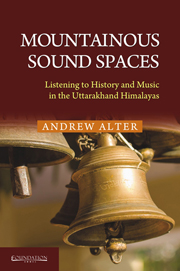Book contents
- Frontmatter
- Contents
- List of Figures
- List of Tables and Musical Examples
- Preface
- Acknowledgements
- Introduction
- 1 Echoes of Colonialism: Bagpipes in the Himalayas
- 2 Echoes of a Royal Heritage: Vestiges of Naubat
- 3 Possession and Performance: Sounding Out the Epic Worlds of Heroes and Gods
- 4 Worlds of Sound: Revisiting the Parameters of Oral Tradition
- 5 Flutes, Sprites and Mountainous Geographies
- 6 Drum Strokes, Syllables and Rhythmic Patterns
- 7 The Significance of Tantric Sects for Drum Practice in the Central Himalayas
- 8 Playing History: Sounding Out the Epic Worlds of Heroes and Gods
- 9 The Legacy of Garhwali Cassettes: Remembering the Pre-digital Age of Music Commodification
- Epilogue: Listening to an Uttarakhandi Himalayan Space
- Bibliography
- Index
Introduction
Published online by Cambridge University Press: 05 October 2014
- Frontmatter
- Contents
- List of Figures
- List of Tables and Musical Examples
- Preface
- Acknowledgements
- Introduction
- 1 Echoes of Colonialism: Bagpipes in the Himalayas
- 2 Echoes of a Royal Heritage: Vestiges of Naubat
- 3 Possession and Performance: Sounding Out the Epic Worlds of Heroes and Gods
- 4 Worlds of Sound: Revisiting the Parameters of Oral Tradition
- 5 Flutes, Sprites and Mountainous Geographies
- 6 Drum Strokes, Syllables and Rhythmic Patterns
- 7 The Significance of Tantric Sects for Drum Practice in the Central Himalayas
- 8 Playing History: Sounding Out the Epic Worlds of Heroes and Gods
- 9 The Legacy of Garhwali Cassettes: Remembering the Pre-digital Age of Music Commodification
- Epilogue: Listening to an Uttarakhandi Himalayan Space
- Bibliography
- Index
Summary
A Himalayan Sound Space
The Himalayas are usually assumed to encompass a space in which the vertical dimension is emphatic. They ‘tower’; they ‘thrust’; they ‘perch.’ Climbers go to the Himalayas to move upwards and reach the peak. Tibet – ‘the roof of the world’ – lies somewhere high above the vantage point of the viewer from the plains. British surveyors like George Everest and Andrew Waugh could see the highest of these mountains sticking up in the distance, a natural border to their newly colonized subcontinent. Well before the British, the Pandavas – heroes of the Mahābhārata – were exiled for thirteen years into the mountains. Later, they ended their days moving upwards again towards that inaccessible high ground of eternal snow. Here, Shiva – carrying a drum – meditated in his mountain abode at Kailash.
Verticality pervades our human visual imagination of a Himalayan space. However, their sonic space is equally integral to the mountains – one that is less considered. It remains invisible and exists in dimensions that are different to the three visible dimensions. Mountains are characterized by mystic silence, yet their spatial dimension and magnitude seem to echo sounds of those who live amidst, or travel through them.
This book presents a number of stories about musical practice in specific regions in the central Himalayas. My words are descriptive of people and the sounds that define them. Those sounds are imagined in ways reflective of histories, conventional attitudes, geographical spaces and mythical worlds. The Himalayas being characterized by diversity of people and geographies are featured by different Himalayan spaces, for instance, urban environments with cosmopolitan populations different to rural settlements; high alpine geographies unlike the flat terai below the foothills; different countries, languages and religions.
- Type
- Chapter
- Information
- Mountainous Sound SpacesListening to History and Music in the Uttarakhand Himalayas, pp. xiii - xviiiPublisher: Foundation BooksPrint publication year: 2014



